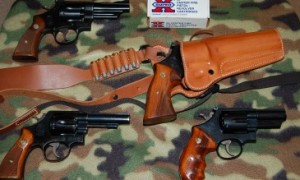Being able to quickly bring a handgun to bear during a Bug Out situation can be essential. In fact, it could be life saving. This includes 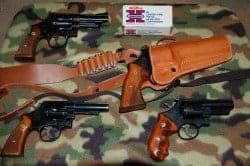 the utilization of a good holster for gun security and carry. Many options are available, some better suited to a Bug Out than others. Let’s take a look. For a measure of perspective, keep in mind during a Bug Out that the travel might or might not be under hostile conditions. If you’re just blending in escaping a natural disaster then there is little need to brandish a weapon.
the utilization of a good holster for gun security and carry. Many options are available, some better suited to a Bug Out than others. Let’s take a look. For a measure of perspective, keep in mind during a Bug Out that the travel might or might not be under hostile conditions. If you’re just blending in escaping a natural disaster then there is little need to brandish a weapon.
By Dr. John J. Woods, a contributing author to Survival Cache & SHTFBlog
Low profile is always the way to go even if you have a concealed weapons permit to carry, keep your guns to yourself until they are needed. Don’t draw attention or inquiring minds might just inquire. Whether you are stopped to fill up at the gas station, running into a grocery store or simply cruising down the highway, it is prudent to have quick and easy access to a handgun. Forget the long guns in a vehicle for fast retrieval and deployment.
When and Where
I want to cover the more obvious contingencies of having to carry a sidearm in a working holster of choice from the moment you leave your primary residence, through the travel process and then when encamped at a final Bug Out destination. Certainly, the same holster(s) can be used for all phases of the scenario, so I don’t mean to suggest getting different units for different situations. However, some may want to consider multiple carry options for various situations, conditions, or circumstances. You may be like me and have an inherent weakness for knives, flashlights and holsters.
For example, I use one vehicle holster set up for actual travel with a back up carry on my person. When I am at my Bug Out camp, around the cabin or yard, I either carry in a crossdraw, chest holster, or maybe a shoulder holster. It is the same if I am patrolling on foot or four-wheeler or hunting. If I am doing some kind of outside physical work, I will likely have the weapon nearby perhaps sitting on the ATV.
Holster Materials
The majority of handgun holsters these days are either made of leather or nylon. Some might be made of a cotton canvas, but those are 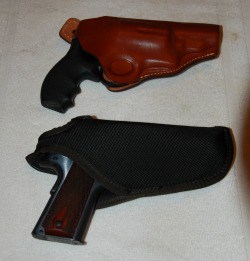 usually military copies or such. I am a huge fan of leather, but they do need periodic care, cleaning, and an application of leather enhancement polishes or creams. I am OK with that bit of maintenance. If your leather holster rigs use any type of a brass rivet(s) at stress points or strap hole adjustment screws, then watch for them to tarnish or coat with a greenish goo. This most often happens during long term storage. Though this gunk is easily removed with some solvent oil and an old toothbrush, it makes a mess. Set up a cleaning area on newspapers before you tackle cleaning these brass fixtures. Then treat the leather with a good leather conditioner, but don’t overdo it to the point of over softening the leather. You want your holster to remain somewhat stiff so it will securely hold the weapon tightly. Another reason I like a safety over-the-hammer strap on mine.
usually military copies or such. I am a huge fan of leather, but they do need periodic care, cleaning, and an application of leather enhancement polishes or creams. I am OK with that bit of maintenance. If your leather holster rigs use any type of a brass rivet(s) at stress points or strap hole adjustment screws, then watch for them to tarnish or coat with a greenish goo. This most often happens during long term storage. Though this gunk is easily removed with some solvent oil and an old toothbrush, it makes a mess. Set up a cleaning area on newspapers before you tackle cleaning these brass fixtures. Then treat the leather with a good leather conditioner, but don’t overdo it to the point of over softening the leather. You want your holster to remain somewhat stiff so it will securely hold the weapon tightly. Another reason I like a safety over-the-hammer strap on mine.
Also Read: Gum Creek Holster Review
Nylon holsters run the gamut from cheap, flimsy fold over and sewn affairs to well made models molded to the exact handgun they are made to fit. I have some of those cheaper $10 holsters for field use, but also some of the better made ones with security hammer straps, sewn closed bottoms to protect the barrel muzzle and even a few with flap designs to fully protect the handgun. Modern so-called cutting edge holsters are also made of polymers such as the material called Kydex. These are molded to the exact gun models and the strong side cant angle can be adjusted. There is usually also a tension screw to adjust the “hold” on the pistol. Newer models have inside lining to protect the gun’s finish. Many of these holsters are attached to inside-the-waistband “pancakes” to fit the rig over your belt. Try one to see if you like them. I don’t personally care for polymer holsters, but you might.
Whatever you decide to buy, make sure it fits the gun you have precisely. Your gun should not flop around inside the holster or easily dump out if you bent over, fall down or while riding an ATV or horse for example. Another reason I like a safety over-the-hammer strap on mine.
Modes of Carry
Holsters basically carry two ways either on the waist with a belt or some sort of shoulder strap affair either as a cross chest holster or an 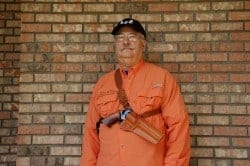 under the arm shoulder holster rig. On the waist it is either a strong side carry, meaning whichever hand you draw and shoot with, right or left-handed. There are a ton of belt carry holster styles, configurations and materials. I do recommend that a waist carry holster should be carried on a belt separate from the one holding up your pants. This allows for taking the rig on and off quicker plus it makes adjustments easier and a far more comfortable carry. The strong side carry is great for walking, hiking, or otherwise standing upright.
under the arm shoulder holster rig. On the waist it is either a strong side carry, meaning whichever hand you draw and shoot with, right or left-handed. There are a ton of belt carry holster styles, configurations and materials. I do recommend that a waist carry holster should be carried on a belt separate from the one holding up your pants. This allows for taking the rig on and off quicker plus it makes adjustments easier and a far more comfortable carry. The strong side carry is great for walking, hiking, or otherwise standing upright.
Waist carry options include the crossdraw style, which I prefer. The crossdraw holster works well for sitting in a vehicle or riding on an ATV, tractor, bicycle or horse. It is easier to reach across your waist to pull a handgun than having to grab back around the grip on the strong side. The crossdraw is a much more comfortable carry when sitting. This is a matter of personal preference so try each type. For shoulder carry holsters can be found to position the handgun vertically under the arm such as the iconic Dirty Harry style or grip forward like so many police detectives seen on TV shows like Don Johnson (aka Sonny Crockett) on Miami Vice. Shoulder holsters seem to work well for heavy, sixgun revolvers either single or double action. Recently I obtained my second Diamond D Custom Leather across the chest carry holster. These are handmade by Diamond D in Wasilla, Alaska. This is fast becoming my favorite mode of carry. With ample adjustment holes to change up strap length, this holster can positioned directly over the sternum or slightly lower to the left for a right-handed draw.
Also Read: G-Code Modular Holster Review
This is a comfortable holster to carry all day either walking or sitting. It can easily be concealed under a goose down vest, jacket or heavy coat, but still retains easy access for quick deployment. When you draw out from this holster, the handgun is naturally pointed and ready to fire. Hence, this is why the holster outfit in Alaska made these for outfitters, bear country hunters and anglers. They are made for both revolvers and pistols with several options available as well. Google them to see their products.
Vehicular Carry and Deployment
When driving in my vehicle either to my optional Bug Out camp just in case I am forced out of my primary Bug In, I install my Gum 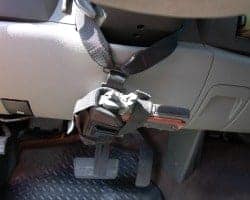 Creek Vehicle Handgun Mount. I most often carry a loaded, cocked and locked 1911 in this rig that goes right under the steering column with an optional under the dash clip and strap arrangement. This positions the pistol in a hidden location unable to be seen from outside the vehicle, but makes access super quick. When drawing from the Gum Creek rig, I can just point out my driver’s window or easily swing my right arm to point out the passenger side. I don’t relish shooting from inside a vehicle, because of the deafening muzzle blast noise, but you do what you might have to do. Know also, you must train on how to shoot with using only one hand, either one, not two from inside a vehicle. Don’t count on having both available, plus it’s awkward anyway.
Creek Vehicle Handgun Mount. I most often carry a loaded, cocked and locked 1911 in this rig that goes right under the steering column with an optional under the dash clip and strap arrangement. This positions the pistol in a hidden location unable to be seen from outside the vehicle, but makes access super quick. When drawing from the Gum Creek rig, I can just point out my driver’s window or easily swing my right arm to point out the passenger side. I don’t relish shooting from inside a vehicle, because of the deafening muzzle blast noise, but you do what you might have to do. Know also, you must train on how to shoot with using only one hand, either one, not two from inside a vehicle. Don’t count on having both available, plus it’s awkward anyway.
Also Read: Gun Buckle Review
If in your Bug Out travels, ultimate concealment is not a real issue then go with a crossdraw holster on the waist. For right-handers this 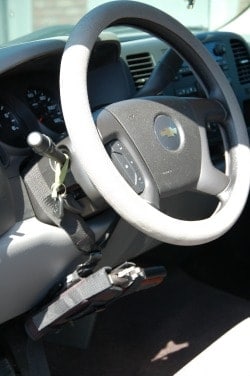 will “hide” the handgun against the driver’s door. Southpaws can wear a light vest to cloak their weapon while seated. Again, the Diamond D across the chest rig is a good option for vehicular carry. It keeps the handgun front and center. If you want to keep it hidden, then get a lightweight snap front down vest from Lands’ End or any number of cotton/nylon vests from L.L. Bean, Orvis, Cabela’s, or Bass Pro Shops. A light fabric fishing vest can also do this job.
will “hide” the handgun against the driver’s door. Southpaws can wear a light vest to cloak their weapon while seated. Again, the Diamond D across the chest rig is a good option for vehicular carry. It keeps the handgun front and center. If you want to keep it hidden, then get a lightweight snap front down vest from Lands’ End or any number of cotton/nylon vests from L.L. Bean, Orvis, Cabela’s, or Bass Pro Shops. A light fabric fishing vest can also do this job.
As sort of a sidebar comment here, any time you carry a handgun on your person this is justification for obtaining a concealed weapons permit. I have the Enhanced Permit that required me to shoot a short-range course of 80-rounds under the tutelage of a certified instructor. This allows more legal carry in more places. Carry your card with you on a Bug Out just in case you may be stopped by official authorities at a road stop or other highway inspection points. There is no need to create trouble for yourself even under emergency conditions when everybody is already on edge anyway. Holsters are an essential tool for carrying handguns. You will want one for waist or shoulder carry during a Bug Out for self-protection. At your back up hide out you will want to carry a handgun for camp security, perimeter patrolling and peace of mind. Get a good, comfortable holster in the carry style you prefer that keeps your handgun at the ready.


